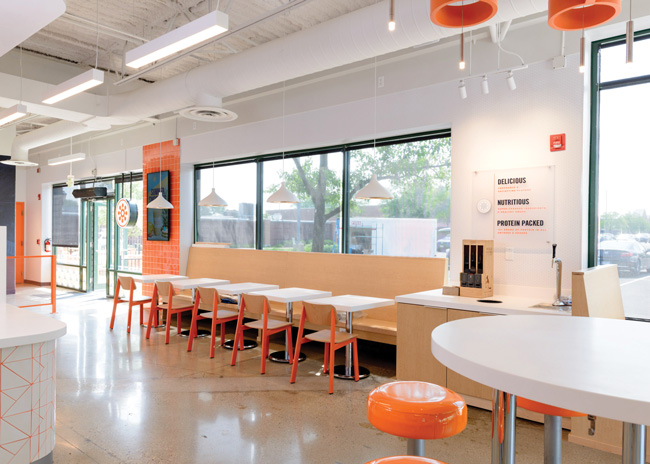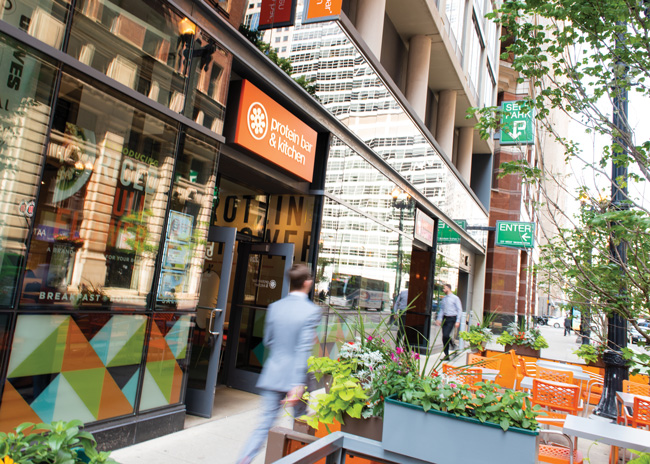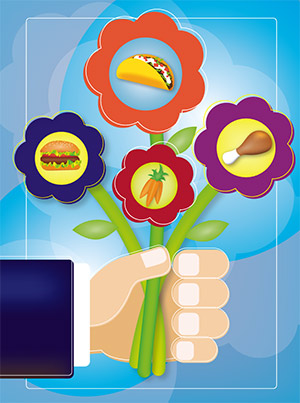Protein Bar & Kitchen (PBK) is primed for growth. The Chicago-based concept, which launched in 2009, has 12 corporate locations, all in Chicago, one licensed operation (at Northwestern University) and is leaping into franchising. Jeff DrakeJeff Drake joined the company as CEO and president in early 2017, prepared to rejuvenate the company and ready it for growth. He spent 2017 and 2018 working with his team to reposition the brand, redesigning it and adding “& Kitchen” to the name “to convey that we offer food,” he says. He also worked hard to elevate the culinary offerings and get the systems and operations in place, both for corporate growth and for future franchisees.
Jeff DrakeJeff Drake joined the company as CEO and president in early 2017, prepared to rejuvenate the company and ready it for growth. He spent 2017 and 2018 working with his team to reposition the brand, redesigning it and adding “& Kitchen” to the name “to convey that we offer food,” he says. He also worked hard to elevate the culinary offerings and get the systems and operations in place, both for corporate growth and for future franchisees.
Protein Bar & Kitchen started by offering drinks but expanded into food and now has a diverse menu that encompasses breakfast, lunch and dinner that includes made-to-order shakes, smoothies, breakfast scrambles, acai bowls and snacks.
Why is now the time to franchise Protein Bar & Kitchen?
JD: We have spent 15 years refining the brand and applying our learnings to prepare this for franchisees. With 12 corporate locations, we know what works and what doesn’t.
We were ready in February 2020, but then we had to hold and navigate through that incredible storm. We had our FDD [franchise disclosure document] ready and opened our first prototype in Northbrook, Ill., in June of this year. That’s the restaurant we’re looking to use for franchising.
We took all our learnings from pre-pandemic and post-pandemic — in how the customer has changed especially for digital — so we could pivot with all our customers on digital platforms.
How will you grow, via franchising, geographically?
JD: Our initial strategy for franchising is we’re targeting to be very close to the Chicago market. It’s important that our first few franchise partners are successful, and our proximity will enforce that. We are also launching another corporate location at Chicago’s O’Hare airport, which will open in early 2024.
After that, we’ll look for franchise partners who want to open three to five locations in an area where PBK doesn’t exist but has strong brand recognition. We’ll look at surrounding states, such as Missouri, Iowa, and Wisconsin. We want concentric circles going out as we grow, leveraging both the brand awareness but also our support and distribution infrastructure. We’ll be disciplined and grow to areas we can be close to so we can provide support and so there is brand recognition.
 Combining a 2019 expansion plan and what they learned from the pandemic, Protein Bar & Kitchen is ready for strategic growth. Images courtesy of PBK
Combining a 2019 expansion plan and what they learned from the pandemic, Protein Bar & Kitchen is ready for strategic growth. Images courtesy of PBK
How will you attract franchisees/get the word out?
JD: We’ve been getting inquiries since I started in January 2017. We weren’t ready, but we are beginning to start some marketing campaigns, primarily through digital — social media and LinkedIn. We’ll also be attending conferences and we’ve added a vice president of franchise development, and we’ll be leaning into him to help launch and get the word out. We’ve put a shingle out, and we’re ready for franchising.
We still get a lot of inquiries. A lot of people come and visit Chicago, then they go back home and inquire if they can open there. We’re not ready to go to those places yet, but it’s very rewarding to see people need to have one of these where they live. We’ll get there, just not right away.
You just launched a new prototype with a streamlined kitchen equipment package, low build-out costs, and flexible footprints; tell me more about your goals with the prototype.
JD: The prototype, which we opened in June of 2023, is 1,800 square feet with 50 seats inside. It’s in a daily use center with Trader Joe’s as a co-tenant. For our real estate, it’s important to be really convenient in people’s lives.
The prototype has a separate entrance for digital orders so those people can get to the shelf to grab their food as quickly as possible. We’re trying to create a pleasant, efficient experience for everyone — to keep the Uber Eats and DoorDash drivers coming in through one door, and the other guests coming in to order through a different entrance. We also shrank the back of the house and streamlined the equipment. When I arrived, PBK was an incredibly entrepreneurial company, which is great but can be a challenge when you are trying to create standards. We took the learnings from all of them and took the best practices and implemented them into this restaurant, and this is the one we’ll be using going forward for corporate and franchised stores.
We also shrank the back of the house and streamlined the equipment. When I arrived, PBK was an incredibly entrepreneurial company, which is great but can be a challenge when you are trying to create standards. We took the learnings from all of them and took the best practices and implemented them into this restaurant, and this is the one we’ll be using going forward for corporate and franchised stores.
Our kitchens don’t need a lot of equipment and the equipment package costs $100,000 to $120,000, which really gives us a leg up on some of
our competitors.
We also made the back of house much more efficient, especially for things like our catering program, which is a strong business for us. The goal is to make sure that in each store we have the appropriate amount of labor but not an unnecessarily large team.
We also improved some equipment. All of our proteins come in fully cooked sous-vide, which gives us consistency. We were able to find a Turbo Chef oven with two chambers instead of the former one and it’s ventless and doesn’t require a hood, which is a significant cost savings. Having two chambers allows us to improve the amount of product we cook and to deliver the product in a much more consistent manner.
This prototype is also adaptable to different real estate, with smaller locations having fewer seats. Though as we expand and go to warmer climates, we might be able to add some outside. But for most locations we’ll look for 1,500 to 2,000 square feet.
We still have a lot of dine-in business. Overall, business is about 50/50 dine-in and off-premises and of the people who come in and order at the register, about 90% dine in the restaurant.
The kiosk is a second type of prototype.
How many locations do you expect to have in the next five years?
JD: The overall target is to be at 100 locations by the end of 2028. I think growth will be gradual. Maybe we’ll open three or four locations next year and then it will exponentially grow. The first franchisees’ success is paramount to our franchising program, so we’re focused on finding the right franchise partners at the beginning.
We’ll continue to grow our corporate stores but franchising growth will outpace corporate growth.



